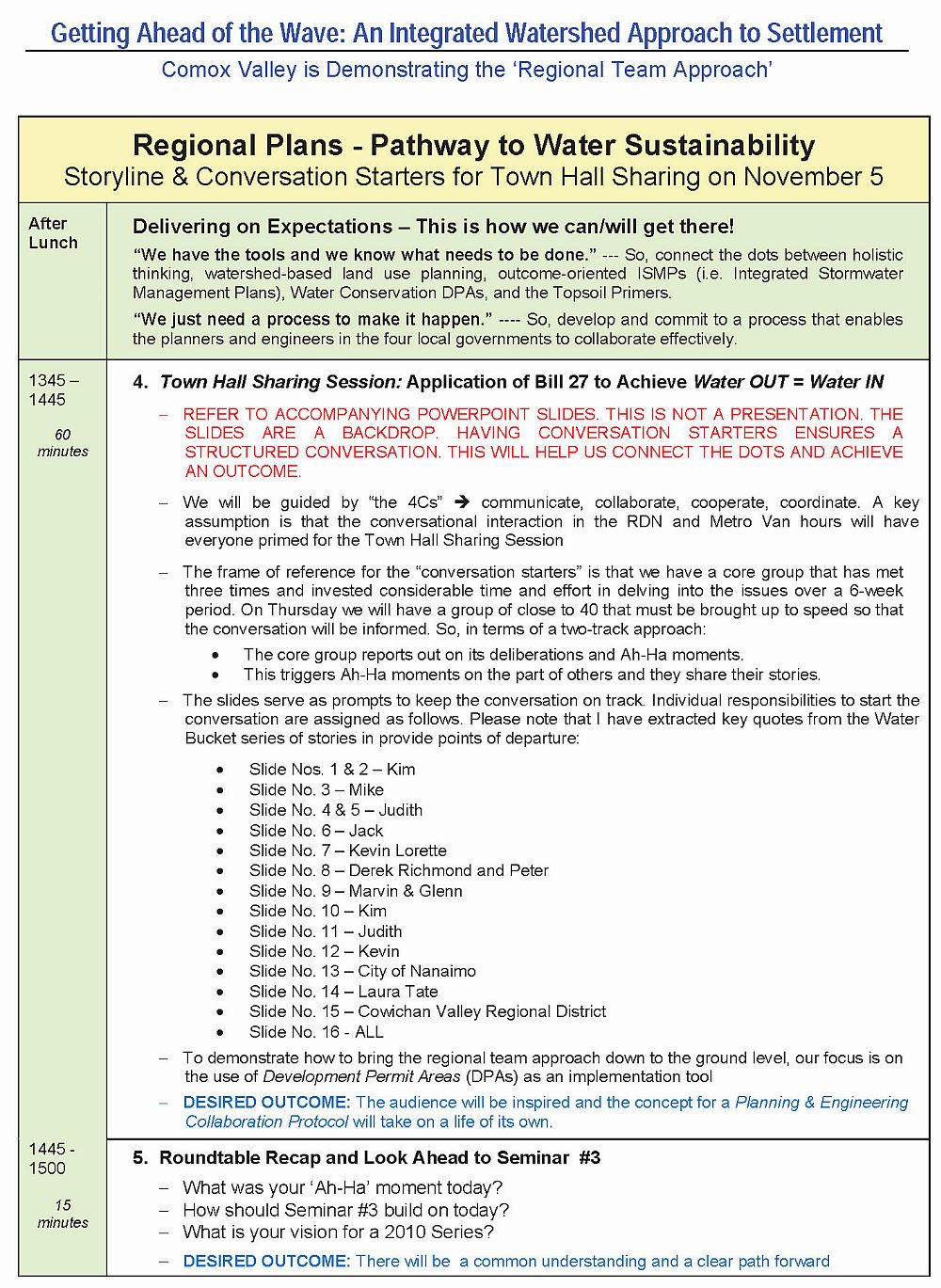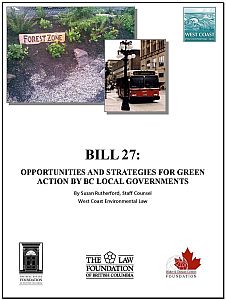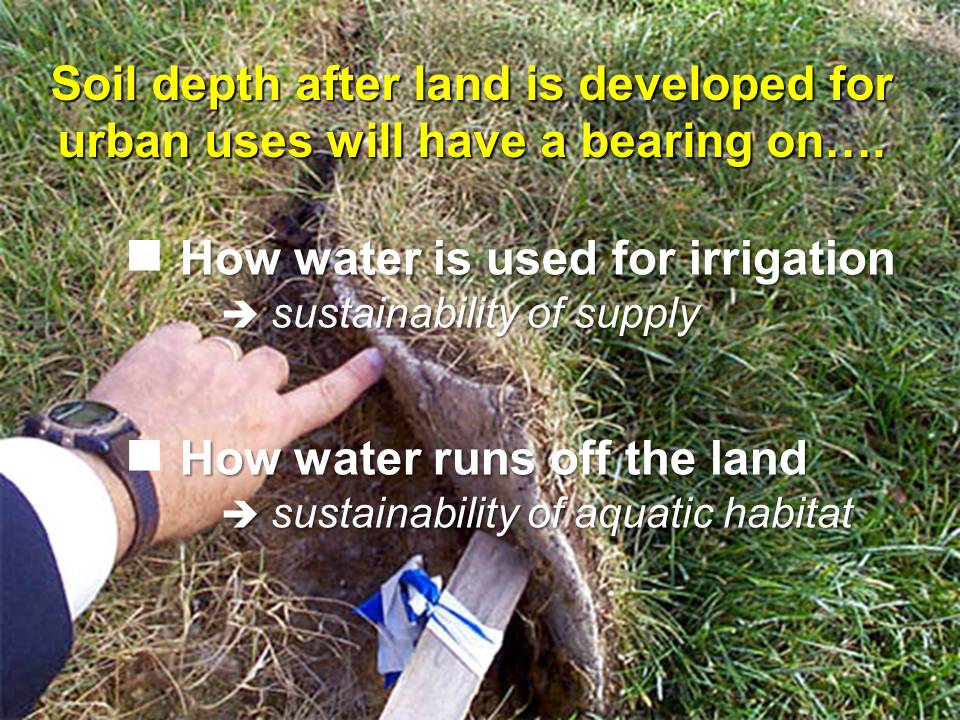GETTING AHEAD OF THE WAVE: Town Hall Sharing Session at Comox Valley Seminar #2 focused on how local governments can apply Bill 27 to achieve "Water OUT = Water IN"
Note to Readers:
The main purpose of this article is to manage the expectations of those attending the second seminar in the 2009 Comox Valley Learning Lunch Series. A secondary purpose of the article is to inform interested readers who wish to learn about and/or understand how the “Comox Valley process” is unfolding.
The purpose of the Learning Lunch Series is to demonstrate how planners and engineers can align their efforts and collaborate under the umbrella of a ‘regional team approach’ to achieve a community vision.
The focus of the article is on the Town Hall Sharing Session in the final hour of Seminar #2. To have the complete picture of how the day is structured, readers should click on CAVI releases program details for Seminar #2 in Comox Valley Learning Lunch Series — Seminar theme is “Regional Plans – Pathway to Water Sustainability”.
The Town Hall Sharing Session will be preceded by, and informed by, bold water-centric planning initiatives that are currently underway in Metro Vancouver and the Regional District of Nanaimo.
Vision for Town Hall Sharing Session
“In planning Seminar #2, the mantra of the Comox Valley organizing team has been ‘go light on presentation and heavy on conversational interaction’. This mantra helps keep everyone’s eye on the goal – which is to create an atmosphere that makes it easy to share and learn,” explains Kim Stephens, seminar moderator and Program Coordinator for the Water Sustainability Action Plan for British Columbia.
Share and Learn
“Our hope is that the telling of the RDN and Metro Vancouver stories will help participants connect the dots to their individual situations. In this way, we believe the RDN and Metro Vancouver hours can inform and/or set the scene for the Town Hall Sharing Session when the spotlight will be squarely on Bill 27. In other words, participants will have a new context for viewing what they do in their day jobs.”
 “A challenge in designing Seminar #2 is that we have to manage two sets of expectations. On the one hand, there is the Comox Valley team that is investing considerable time and effort in the period between seminars to make the regional team approach real. And on the other hand, there are those who are only coming together for the seminars themselves.”
“A challenge in designing Seminar #2 is that we have to manage two sets of expectations. On the one hand, there is the Comox Valley team that is investing considerable time and effort in the period between seminars to make the regional team approach real. And on the other hand, there are those who are only coming together for the seminars themselves.”
“Stories provide a focus. Our vision is that everyone will learn from the sharing of stories. The members of the Comox Valley team will report out on their efforts to date and we will see where the conversation goes. We are also encouraging participants from beyond the Comox Valley to tell their stories.”
Conversation Starters
Download a copy of the PowerPoint slides that served as conversation starters: Seminar #2 Town Hall.



Green Communities legislation creates opportunity for action
In May 2008, the “Green Communities” legislation known as Bill 27 amended the Local Government Act and Community Charter. In June 2009, West Coast Environmental Law released a discussion paper written by Susan Rutherford and titled Bill 27: Opportunities and Strategies for Green Action by BC Local Governments.
To Learn More:
Download a copy of Bill 27: Opportunities and Strategies for Green Action by BC Local Governments.
Use of Development Permit Areas
“Local governments are now empowered to designate a development permit area having the purpose of the establishment of objectives to promote (among other things) water conservation,” writes Susan Rutherford.
In her paper, Susan Rutherford suggests a number of guidelines that might be considered, and concludes that: “A compatible policy initiative would be to promote adoption by the region of an ecosystem-based approach to watershed planning and establishment of watershed targets, with guidance that would be linked.”
 “Building on the guidance flowing from Susan Rutherford’s paper, the Comox Valley team is in the early stages of figuring out how the four local governments can develop a common approach to water sustainability,” reports Kim Stephens.
“Building on the guidance flowing from Susan Rutherford’s paper, the Comox Valley team is in the early stages of figuring out how the four local governments can develop a common approach to water sustainability,” reports Kim Stephens.
“It has been fascinating to be part of the conversation between planners and engineers about the potential use of Development Permit Areas to achieve Water OUT = Water IN. It was the engineers who posed the question: what if? The initial response of the planners was: there may be other better tools.”
“Their continuing conversation has resulted in the planners viewing the context differently. They have seen the value of what has been suggested, and they have begun to wrap their minds around how to integrate a planning tool with engineering objectives and criteria.”
Water OUT = Water IN
“In 2005, we introduced the Water OUT = Water IN mind map to help practitioners and others think holistically about water issues,” explains Kim Stephens. “It was a way to portray complexity in a way that we believed people could intuitively understand.”
“The equation is deceptively simple, yet it embodies the basic principles and concepts for dealing with uncertainty and managing risk. It allows us to draw attention to the elements of the water cycle, how we allocate and use water, and make the point that water and land uses are inter-connected.”
To Learn More:
Download a PDF copy of Dealing with Uncertainty and Managing Risk: How We Can Adapt our Water Management Systems. To download a copy of the accompanying PowerPoint slides, click here.
Green Infrastructure = Water Sustainability
“There is more to water conservation than low-flush toilets and water-saving showerheads. In addition to water use within homes and buildings, water conservation encompasses what we do on the landscape. This goes to the heart of land development practices. It is a matter of connecting the dots,” states Shelley Ashfield, an engineer with the Town of Comox.
“An absorbent topsoil layer, for example, has emerged as a fundamental building block for achieving water sustainability through implementation of green infrastructure practices. In this case, the targeted outcomes are: use less irrigation water to achieve sustainability of water supply; and reduce rainwater runoff to achieve sustainability of aquatic habitat.”
“So, how do local governments align law, policy and technical tools to achieve a desired outcome? That is what we will be exploring at Seminar #2 when the theme is Regional Plans – Pathway to Water Sustainability.”
Establishing expectations as to what is an acceptable development application
“At Seminar #1, the spotlight was on the large-scale projects that are planned for the east coast of Vancouver Island, and we learned that the big guys have embraced green value development. At Seminar #2, the spotlight will shift to the small-scale developers,” states Kim Stephens.
“The reason for this dual focus is that both the large-scale and the small-scale developers need to follow the same rules of engagement. Everyone must have a clear understanding of expectations.”
Educating Small-Scale Developers
“An outcome of Seminar #1 is recognition of the need to focus small-scale developers on their responsibility to submit a complete application,” reports Kevin Lagan, Director of Operational Services with the City of Courtenay. “Until the application is complete, it is  only a conversation and is not on the table.”
only a conversation and is not on the table.”
“As an action item flowing from Seminar #1, and in order to facilitate the developer education process in Courtenay, the City is reviewing how it does business and how it can be more explicit in establishing expectations.”
“We have invited planning and engineering staff from the other three Comox Valley local governments to collaborate with us in developing and implementing a regional team approach to handling development approvals. An important objective is region-wide consistency at front counters.”
Nanaimo’s Green Design Guidelines
“During the Town Hall Sharing Session at Seminar #2, participants will learn how the City of Nanaimo is tackling the ‘expectations issue’ through its Green Design Guidelines. How one deals with small-scale developers seems to be a universal issue of concern to local governments,” adds Kim Stephens.
“We are developing an incentive-driven checklist because we want all applicants to have the same information and knowledge, especially the small-scale developers,” states Rob Lawrance, Environmental Planner with the City of Nanaimo. “Our goal is to be clear regarding the City’s expectations. This starts with how one looks at the landscape before even thinking about what the building might be like.”
To Learn More:
To read an earlier story about the City of Nanaimo experience, click on Turning the tide in the City of Nanaimo: Inland Kenworth truck and equipment facility showcases what ‘green value’ development can look like.






